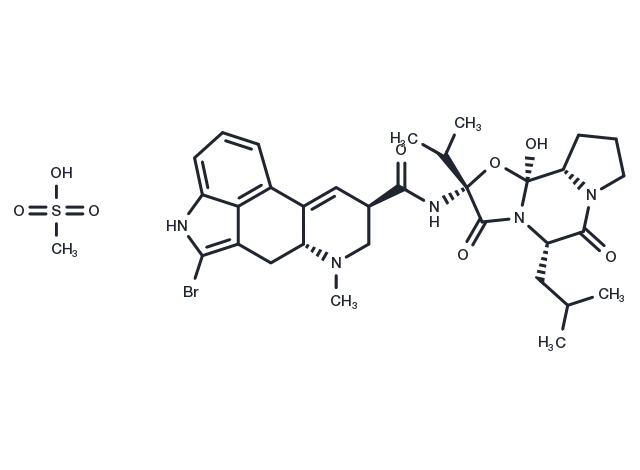Powder: -20°C for 3 years | In solvent: -80°C for 1 year


Bromocriptine mesylate (CB-154) is a potent dopamine receptor agonist that binds the D2 receptor with highest affinity (Ki = 2.5 nM)

| Pack Size | Availability | Price/USD | Quantity |
|---|---|---|---|
| 100 mg | In stock | $ 59.00 | |
| 1 mL * 10 mM (in DMSO) | In stock | $ 55.00 |





| Description | Bromocriptine mesylate (CB-154) is a potent dopamine receptor agonist that binds the D2 receptor with highest affinity (Ki = 2.5 nM) |
| Targets&IC50 | D2:2.5 nM(ki) |
| In vitro | The ergot alkaloid bromocriptine (BKT) was found to act as a strong inhibitor of purified neuronal nitric oxide synthase (NOS) (IC50 = 10 +/- 2 microM) whereas it was poorly active towards inducible macrophage NOS (IC50 > 100 microM). BKT affects the activation of NOS by calmodulin, as it not only inhibits L-arginine oxidation to NO and L-citrulline but also NADPH oxidation and calmodulin-dependent cytochrome c reduction catalyzed by neuronal NOS. These results suggest that BKT could exert some of its therapeutic effects by interfering with the NOS-dependent formation of nitric oxide and/or superoxide ion in various tissues. |
| Synonyms | CB-154 |
| Molecular Weight | 750.7 |
| Formula | C33H44BrN5O8S |
| CAS No. | 22260-51-1 |
Powder: -20°C for 3 years | In solvent: -80°C for 1 year
DMSO: 30 mg/mL (39.96 mM)
You can also refer to dose conversion for different animals. More
bottom
Please see Inhibitor Handling Instructions for more frequently ask questions. Topics include: how to prepare stock solutions, how to store products, and cautions on cell-based assays & animal experiments, etc.
Bromocriptine mesylate 22260-51-1 Autophagy GPCR/G Protein Neuroscience Dopamine Receptor Bromocriptine Mesylate Bromocriptine CB 154 Inhibitor inhibit CB-154 CB154 inhibitor
